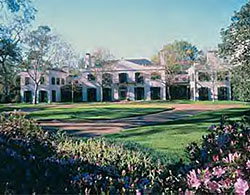History
In 1836 Augustus and John Allen established a small settlement
along a muddy and mosquito-infested area of the Buffalo Bayou.
They named the town after Sam Houston, who had won independence
for Texas at the Battle of San Jacinto earlier that year. Houston
prospered, and in 1914 the winding bayou was converted into a
shipping channel, fueling the city's growth as a center for timber,
cotton, and cattle shipping. In the early twentieth century, an
oil boom assured Houston's future as a world energy center.
By the 1920s
Houston, many of Houston's leading citizens joined forces to control
growth and to formulate ideas for planning and beautification.
Although many of their proposals were never realized, the city
benefited immeasurably from these efforts. Will Hogg gave his
own land to the city to create Memorial Park and other public
green spaces.
Will Hogg's
commitment to urban planning was matched by his entrepreneurial
spirit. In 1924, Will and Mike Hogg and their associate Hugh Potter
began planning a lush subdivision, away from the noise, dirt,
and congestion of the city. They built River Oaks, the new suburb,
on 1100 acres of open farmland and rustic woodlands three miles
west of downtown Houston. Advertised as a "distinguished
experiment in fine living," it became a national model for
community planning.
In the heart
of River Oaks, Houston's most elegant residential area, an eighty-acre
lot was a separate subdivision called Homewoods. This enclave
contained just fourteen lots, the largest of which was reserved
by the Hoggs and would become Bayou Bend.
Architecture
The house, designed by prominent architect John F. Staub, was
built between 1927 and 1928. Miss Hogg and her brothers wanted
the design of their new home to reflect the history, culture,
and climate of the Texas Gulf Coast.
Staub's plan
for Bayou Bend combined the refined symmetry of eighteenth-century
English Georgian architecture with the romantic influence of Spanish
Creole architecture from New Orleans. In fact, the antique wrought
iron balcony on the southern facade of the house was salvaged
from a demolished New Orleans building. Bayou Bend's central hallway,
curving stairway, columned northern portico, and double frontage--are
borrowed from Southern plantation houses. Miss Hogg coined the
term "Latin Colonial" to describe the eclectic new style.
The interiors
borrow more heavily from the architectural traditions of the North.
In 1920 Miss Hogg had begun assembling an important collection
of American decorative arts. To provide suitable settings for
these extraordinary antiques, Staub designed simple but stately
interiors in the style of colonial American rooms. In Miss Hogg's
bedroom and sitting room, he incorporated floorboards and paneling
rescued from two eighteenth-century Massachusetts houses.
Gardens
The gardens presented a special challenge. Covered in towering
trees and thick undergrowth, the site was, in Miss Hogg's words,
"nothing but a dense thicket." Undaunted, she created
a series of gracious and beautiful gardens that were intended
as outdoor rooms for living and entertaining, not just views to
be admired from within the house. But Miss Hogg was also appreciative
of the wilder side of nature, and she always intended that the
surrounding woodlands, remain more or less natural, as they are
today.
back
